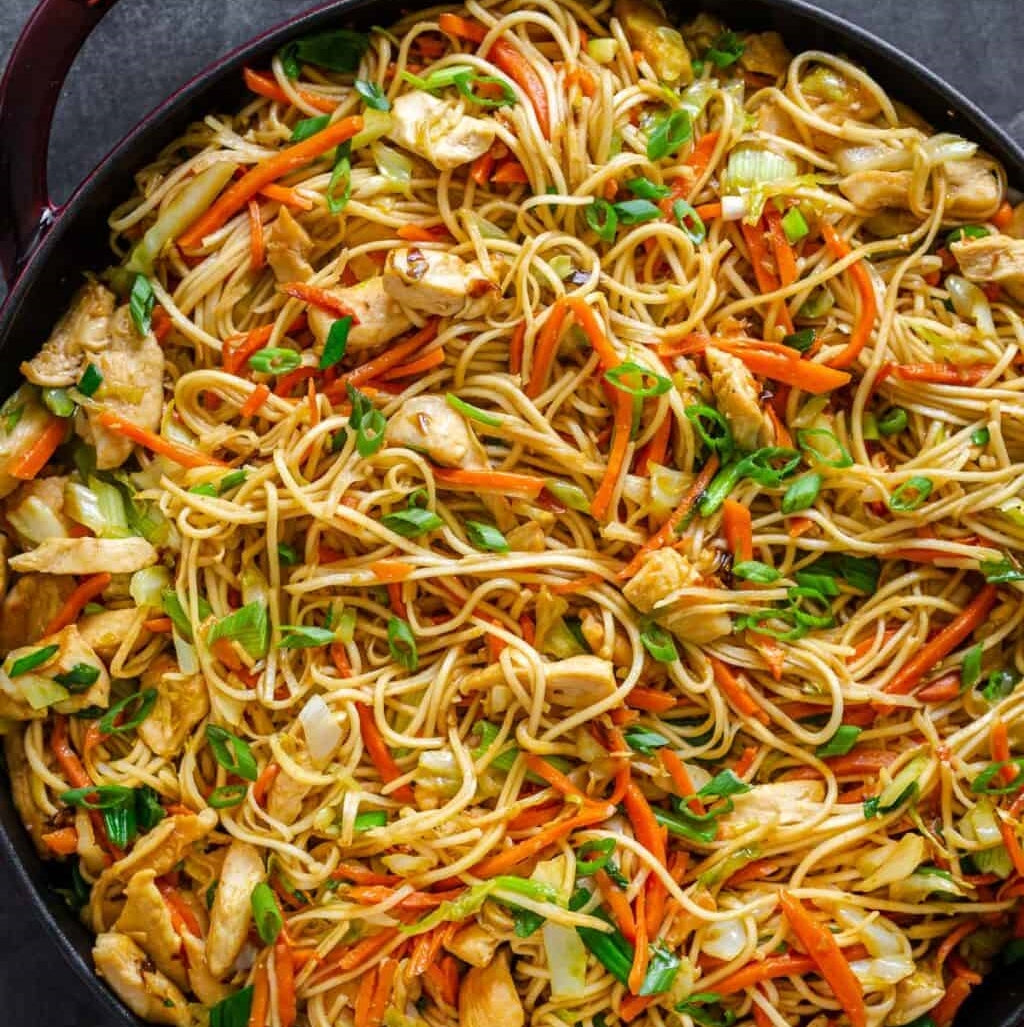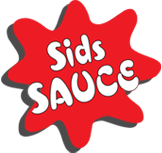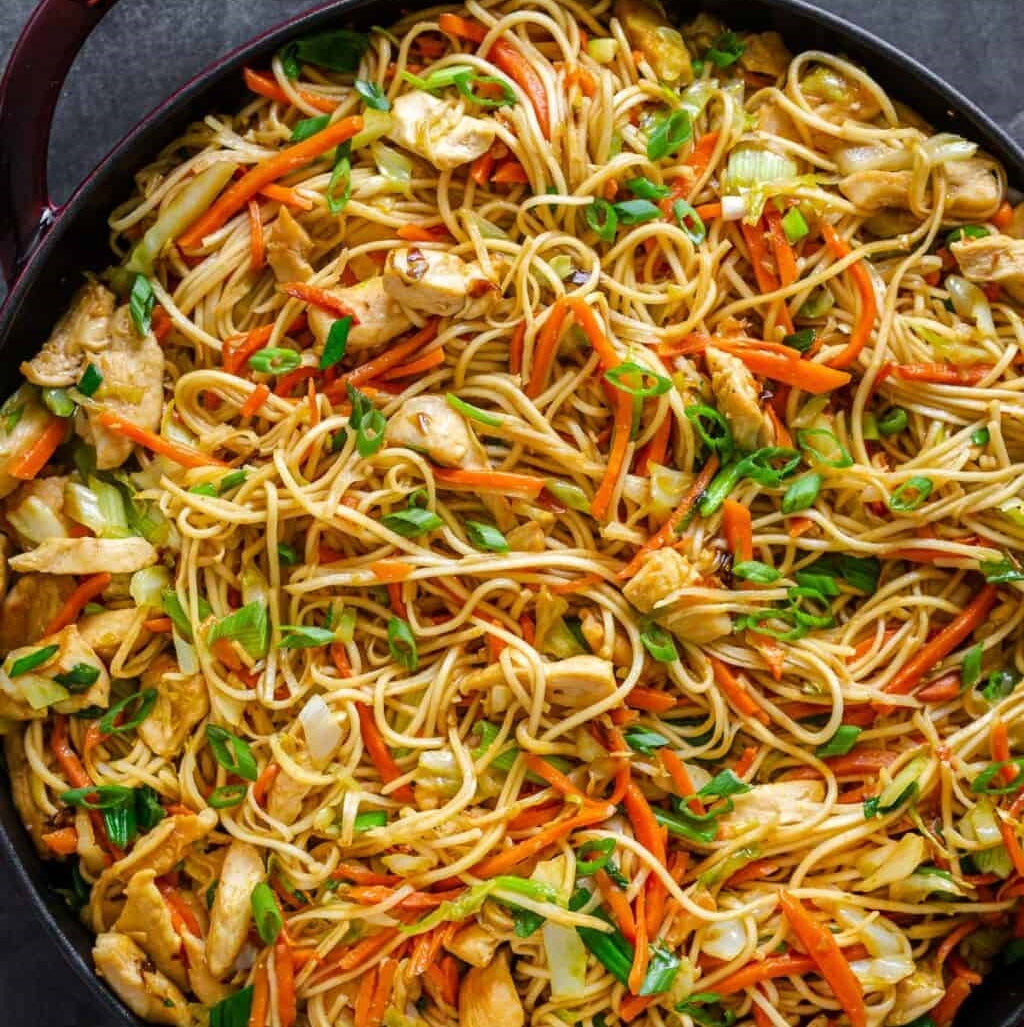Chicken Chow Mein
Chicken Chow Mein
We make this delicious chicken chow mein recipe with real Chinese chow mein noodles, (while many recipes out there use a soft lo-mein-like noodle) crunchy vegetables, and lots of juicy chicken.
Ready in: 35 minutes
Serves: 4
Complexity: very-easy
kcal: 531
Share

Ingredients
480 g egg noodles
2 tsp sesame oil, plus more as needed
1.2 kg chicken breasts, sliced in strips
Dash of dark soy sauce
1½ tsp five-spice powder
2 tsp chilli sauce
2 tbsp cornflour
4 tbsp peanut oil
2 orange bell pepper, seeded & fine sliced
100 g bean sprouts
2 large spring onion, sliced lengthwise
4 tbsp light soy sauce
SIDS SALT & PEPPER to taste
Directions
Cook the noodles for 3 minutes in a pan of boiling water until al denté, as per the package instructions. Drain, then run them under cold running water and drain again. Drizzle with a few splashes of sesame oil and toss through to prevent them from sticking.
Season the chicken with a splash of dark soy sauce, five-spice powder and chilli sauce. Mix well. Coat the chicken breasts lightly with the cornflour.
Heat a wok over a high heat, add the peanut oil and heat until smoking. Add the chicken and stir-fry for 2-3 minutes, until cooked through.
Add the bell pepper and stir-fry for 1 minute, then add the bean sprouts and spring onion and stir-fry for less than 1 minute. Add the cooked noodles and season with the light soy sauce, 1 teaspoon toasted sesame oil and SIDS SALT & PEPPER, to taste. Stir well and serve immediately.
HISTORY:--
SO WHAT IS CHICKEN CHOW MEIN?
“Chow mein,” or more accurately pronounced, “chow meen” in Cantonese, literally translates to “fried noodles” or “pan-fried noodles.”
When we think of chow mein noodles, we think of a Cantonese Hong-Kong-style pan-fried noodle, which you can buy fresh or dried in Chinese grocery stores. The noodles must first be boiled briefly, then drained. Then they can be pan-fried/stir-fried.
The fresh noodles freeze well. (we always have a bag in the freezer in case we get a craving or want to make a quick weekday meal) The dried chow mein noodles are a great pantry item to have and are very similar to the fresh noodles after boiling. We also keep these on hand because they’re shelf stable and easy to cook!
After Chinese immigrants first started coming to the U.S. in the mid-1800s, chow mein was one of the first Chinese foods to hit mainstream America, along with dishes like chop suey and fried rice. Most of these early Chinese immigrants were from Canton (Guangzhou) in Southern China. Chow mein as we know it today evolved from Cantonese cooking.
However, the most retro Americanized takeout version of Chicken Chow Mein isn’t a noodle dish at all, but rather a stir-fry served over rice! Yet another dish you could call Chicken Chow Mein is one you can find at Cantonese dim sum restaurants—gai see chow meen, which translates to “pan-fried noodles with chicken strips.” Then you have this version that we’re making today.
In other words, chicken chow mein comes in different forms, depending upon where you’re eating or what recipe you’re following, and quite frankly it can be confusing! Below, we’ve put together a bit of a chow mein guide to these versions and their key differences in detail:
3 DIFFERENT VERSIONS:
AMERICAN CHICKEN CHOW MEIN
Find it at: Chinese-American takeout restaurants, though the dish is rapidly disappearing.
We think this version of chicken chow mein first appeared in the U.S., created with locally available ingredients. We call it American chicken chow mein, and it’s made with cooked vegetables (like onions, celery, mushrooms, and canned bamboo shoots, bok choy, cabbage, and water chestnuts) in a thick sauce, topped with chicken and fried crispy noodles. Generally served with steamed rice on the side, it’s not a noodle dish at all!
The only noodle element is the crispy deep-fried noodles on top, which is essentially a crunchy garnish. Older people (the Baby Boomer generation) probably remember this once iconic dish best. In the 60s and 70s, lo mein was one of the only fresh noodle dishes on the menu at a local Chinese restaurant. Mei fun (thin rice noodles), chow fun (flat rice noodles), and chow mein (pan-fried noodles) were not as common.
While back in the day, the dish was served in sit-down Chinese restaurants, it can usually only be found in takeout joints today. That said, this version of chicken chow mein is rapidly disappearing, as other more popular takeout dishes have come into the mix to take its place. If you’re looking to recreate it at home, check out our American chicken chow mein recipe.
If you’ve been to a dim sum restaurant, you’ve probably seen Chinese families enjoying rice or noodles with their dim sum spread. There are a variety of noodle dishes hailing from Hong Kong and Guangzhou that you can order along with your har gow, char siu bao, steamed spare ribs with black bean, and other dim sum delicacies.
These noodle dishes generally fall into those categories mentioned previously: mei fun, (thin rice noodles) chow fun, (wide flat noodles) and chow meen. (pan-fried noodles) You might encounter Xiamen Mei Fun or Singapore Mei Fun in the mei fun category. When it comes to chow fun, Dry Beef Chow Fun and “Wet” or Saucy Beef Chow Fun are super popular dishes.
Under the pan-fried noodle section, Gai see chow meen, or pan-fried noodles with chicken strips, is one of the more popular dishes. This other version of Chicken Chow Mein involves frying Hong-Kong-style pan-fried noodles into a round, crispy cake, and then stir-frying a mixture of chicken strips, green vegetables (usually choy sum) and perhaps additional veggies like carrots or mushrooms in a flavorful white sauce.
Chefs then ladle this chicken and vegetable mixture over the top of the crispy noodle cake. The sauce seeps into the noodles, creating a contrast of textures—crispy noodles alongside saucy noodles! Other versions of the dish may include beef, pork, seafood, or just vegetables. See our recipes for Gai See Chow Meen and Shredded Pork Pan-fried Noodles to get a better idea of what it looks like!
Finally, you have the version we’re making today, which is a dry homestyle Hong-Kong-Style Chicken Chow Mein. While many pan-fried noodle dishes are served with a saucy stir-fry over the top, as in the previous version, some are stir-fried noodles served “dry.” One example of such a dish is our Cantonese Soy Sauce Pan-fried Noodles.
Today’s version of Chicken Chow Mein follows a similar formula. We’re using the same type of noodles that we use in gai see chow meen, but making a dish without any standing sauce.
We pan fry the Hong-Kong-style thin egg noodles, flipping them until they take on a slightly crispy texture all over. Then we cook the chicken and vegetables, and add the noodles back to the wok. I add sauces and spices, and stir-fry the mixture until it’s well mixed.
Many chicken chow mein recipes you’ll find on the Internet today (particularly from non-Chinese sources) use a softer noodle, like a thin lo mein noodle. But that’s why we think of those recipes as more like a lo mein than a chow mein! (Check out our chicken lo mein recipe to see the difference)
In this easy chicken chow mein recipe, you’re using the correct noodle, and you get a mixture of flavoured soft and crispy noodles. It’s just delicious, and what I think your everyday chicken chow mein should taste like!
Hopefully that helps clear up any confusion you may have had about chicken chow mein, the types served in restaurants, and all the different chow mein recipes out there in the wild!
While this is a chicken chow mein recipe, you have a choice of the usual proteins like beef, pork, shrimp, and chicken. (Check out our Shrimp Chow Mein and Vegetable Chow Mein) You can use any vegetable you like, but it’s best to keep things simple. Follow our recipe to the letter, and you’ll be really happy with the result!

